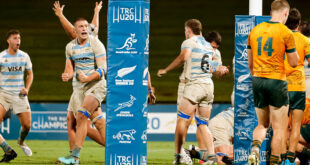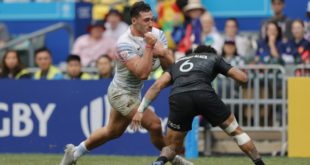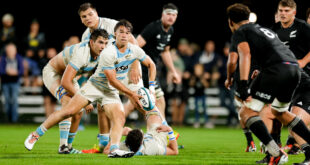It’s hard to believe that another Rugby World Cup has now come and gone. Outside of the unfortunate typhoon incident it was a marvelous tournament, if perhaps somewhat anti-climactic in its finale. Nonetheless as a whole it ranks among the best editions of the flagship tournament with Japan and Uruguay standing beside the record-setting success of South Africa as noteworthy team efforts.
There was no shortage of outstanding individual performances to pore over either. In a first for ARN we covered each and every game of the tournament, choosing to focus only on the Americas games four years ago. Having already named our RWC 2019 Americas Dream Team, a disappointing endeavor truth be told, we’ve decided it’s appropriate to name our own World Cup XV even though suitable candidates from the Americas were difficult to identify.
Some positions were unanimous and followed the status quo, but we took a different route with others while conceding there is plenty of room for debate. Our criteria was somewhat flexible. While overall excellence was the easiest route to selection, it’s a difficult task for players to be at their best for 5, 6, or 7 games in a row. As such certain positions required other considerations.
Also of note is that team success didn’t necessarily translate to representation. New Zealand were the third-best team in the tournament and had only one player selected, while fourth-place Wales had none on our team though several were in contention.
1 – Keita Inagaki (Japan) No lengthy discussion required here for us. Inagaki started all five games for the Brave Blossoms and was outstanding in every one. He has impressed in the past but this was the pinnacle of his career without doubt. A tip of the cap as well to his super-saiyan-sub, Isileli Nakajima. Tendai Mtawarira had a brilliant final but it wasn’t enough to sway our decision, while Jefferson Poirot was a rare mark of consistency for France.
2 – Shota Horie (Japan) A difficult choice with a number of players in the mix, not least the two starters in the final – Bongi Mbonambi and Jamie George. Flying slightly under the radar was Tolu Latu, while others like Ken Owens and Torsten van Jaarsveld went well. Horie brought a different dimension in the loose, like Inagaki playing the best rugby of his career. His ball carrying was simply sensational with his 80-minute performance against Ireland of the highest order.
3 – Frans Malherbe (South Africa) We’re going against the grain slightly here. Kyle Sinckler has been the runaway choice by most, but for us the Springbok front row has been the best with Malherbe the best anchor in the competition. If this was a match day 23 it would be Malherbe to start and Sinckler to run rampant off the bench. Different styles of players but for us, Malherbe did enough to merit his spot in the team despite Sinckler’s credentials.
4 – Guido Petti (Argentina) Sure to be a contentious selection and admittedly showing our Americas bias here. There’s no denying the excellence of Alun Wyn Jones and Eben Etzebeth, either would be acceptable choices. Petti, however, was everything for Los Pumas. He was a constant source of possession in the lineout and ubiquitous in the loose. Started all four games and was rightly given a rousing ovation when he left the pitch in Argentina’s final match against the USA.
5 – Maro Itoje (England) The easiest choice in the team. Imperious in everything he did and one of the stars of the tournament, if not the top player. If England look to a new captain in the next cycle, Itoje must be in the discussion. Just about the only blemish on his record was the rejection of the silver medal, a decision we think he will regret.
6 – Pieter-Steph du Toit (South Africa) Another decision that was relatively straightforward despite the number of standouts. Chris Vui, Aaron Wainwright, Tagir Gadzhiev, and Tom Curry were all outstanding and worthy of recognition among others. du Toit, however, has been deservedly named World Rugby Player of the Year. Where the likes of Wainwright and Curry are ‘hybrid’ types, du Toit is a classic blindside who towers above his opponents with his work rate and athleticism.
7 – Sam Underhill (England) This could justifiably gone to either of England’s flankers though Curry was wearing 6 on his back. We opted for the conventional route here and chose Underhill for his ferocious game-changing tackling and disruptive presence at the breakdown. Justin Tipuric was the next in line. Ardie Savea suffered from a lack of identity – he would make the bench as a utility loose forward reserve but wasn’t really first or second choice at any spot as a specialist for us.
8 – Kazuki Himeno (Japan) Many will lean towards Duane Vermeulen, particularly after his brutal exhibition in the final. A fair choice, he was indeed a class act. We lean towards Japan’s best forward however. Himeno was a colossus for the Brave Blossoms, his ball carrying and work rate among the very best in the competition. He started every match and more than made up for the loss of mostly-injured Amanaki Mafi. A finalist for Player of the Tournament in our opinion.
9 – Faf de Klerk (South Africa) An automatic selection in our eyes. Others have criticised him for kicking too much, but it was clearly the game plan and he executed it to perfection. When given license to attack he did so, and his defense gave the Springboks an advantage that no other team shared. Another who deserves to be among the best in the tourney.
10 – George Ford (England) The most difficult selection in the team largely because there was no true standout. None of the perceived world’s best stood head-and-shoulders above any other. In fact we were tempted to name Felipe Berchesi, such was his influence for Los Teros. Romain Ntamack should signs of genius and Yu Tamura did an admirable job for Japan. Handré Pollard kicked his side to a Webb Ellis Cup win. He wasn’t always convincing, however, and we felt that the overall form of Ford both as a playmaker and tactical kicker was slightly better.
11 – Semi Radradra (Fiji) Along with blindside flanker, the position with the most potential choices was the left wing. Josh Adams led the tournament in tries with Makazole Mapimpi just behind. Kenki Fukuoka provided some of the absolute highlights of the tournament. Radradra started a little slowly but his performances against Georgia and Wales were of the legendary variety. He was such a dominant figure in those matches that he simply had to be selected.
12 – Damian de Allende (South Africa) He likely wouldn’t be our first choice if we were picking a team to win a match for the universe tomorrow, but he was unquestionably an integral part of his team’s success. Rock solid in defense and relentless in his pursuit of the gainline. Samu Kerevi was Australia’s best player held off the likes of Anton Lienert-Brown and Gaël Fickou.
13 – Manu Tuilagi (England) There isn’t much creativity in our midfield but on merit the bulldozer must be included. His match against New Zealand secured his spot in the team. Jonathan Davies was in the picture as our second choice while Lukhanyo Am might have been the tourney’s best defender in the outside center channel.
14 – Kotaro Matsushima (Japan) It came down to three contenders on the right wing. The blinding speed of Sevu Reece was tempting, as was the sharp-stepping Cheslin Kolbe. In terms of the full package, however, we felt Matsushima was a nudge ahead. His bravery under the high ball, scything outside breaks, and surety in the tackle ticked all our boxes. The embodiment of the Japanese spirit.
15 – Beauden Barrett (New Zealand) How many would have predicted only one All Black in the tournament’s XV? We certainly would not have. Perhaps it might be cruel but there were glimpses of complacency in the pool matches and we know how the England game went. Barrett didn’t quite suffer the same fate as his teammates but then again the knock-on against Canada has gone in the shocker bin. Otherwise he provided the extra playmaker that the selectors were looking for to lead the All Black attack. Tim Nanai-Williams and Telusa Veainu were both among their country’s best.
 Americas Rugby News Rugby news from across the Americas!
Americas Rugby News Rugby news from across the Americas!




